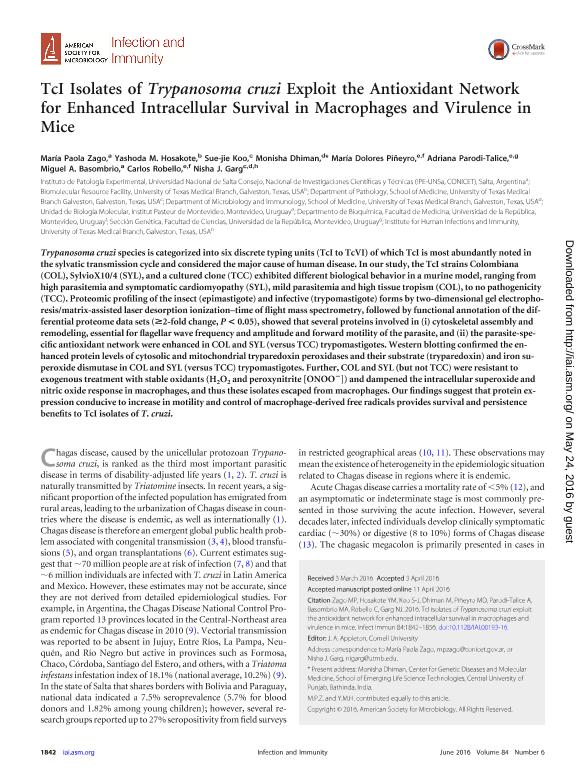Artículo
TcI isolates of Trypanosoma cruzi exploit the antioxidant network for enhanced intracellular survival in macrophages and virulence in mice
Zago, María Paola ; Hosakote, Yashoda M.; Koo, Sue Jie; Dhiman, Monisha; Piñeyro, María Dolores; Parodi Talice, Adriana; Basombrío, Miguel Ángel Manuel
; Hosakote, Yashoda M.; Koo, Sue Jie; Dhiman, Monisha; Piñeyro, María Dolores; Parodi Talice, Adriana; Basombrío, Miguel Ángel Manuel ; Robello, Carlos; Garg, Nisha J.
; Robello, Carlos; Garg, Nisha J.
 ; Hosakote, Yashoda M.; Koo, Sue Jie; Dhiman, Monisha; Piñeyro, María Dolores; Parodi Talice, Adriana; Basombrío, Miguel Ángel Manuel
; Hosakote, Yashoda M.; Koo, Sue Jie; Dhiman, Monisha; Piñeyro, María Dolores; Parodi Talice, Adriana; Basombrío, Miguel Ángel Manuel ; Robello, Carlos; Garg, Nisha J.
; Robello, Carlos; Garg, Nisha J.
Fecha de publicación:
06/2016
Editorial:
American Society for Microbiology
Revista:
Infection and Immunity
ISSN:
0019-9567
Idioma:
Inglés
Tipo de recurso:
Artículo publicado
Clasificación temática:
Resumen
Trypanosoma cruzi species is categorized into six discrete typing units (TcI to TcVI) of which TcI is most abundantly noted in the sylvatic transmission cycle and considered the major cause of human disease. In our study, the TcI strains Colombiana (COL), SylvioX10/4 (SYL), and a cultured clone (TCC) exhibited different biological behavior in a murine model, ranging from high parasitemia and symptomatic cardiomyopathy (SYL), mild parasitemia and high tissue tropism (COL), to no pathogenicity (TCC). Proteomic profiling of the insect (epimastigote) and infective (trypomastigote) forms by two-dimensional gel electrophoresis/ matrix-assisted laser desorption ionization-time of flight mass spectrometry, followed by functional annotation of the differential proteome data sets (≥2-fold change, P<0.05), showed that several proteins involved in (i) cytoskeletal assembly and remodeling, essential for flagellar wave frequency and amplitude and forward motility of the parasite, and (ii) the parasite-specific antioxidant network were enhanced in COL and SYL (versus TCC) trypomastigotes. Western blotting confirmed the enhanced protein levels of cytosolic and mitochondrial tryparedoxin peroxidases and their substrate (tryparedoxin) and iron superoxide dismutase in COL and SYL (versus TCC) trypomastigotes. Further, COL and SYL (but not TCC) were resistant to exogenous treatment with stable oxidants (H2O2 and peroxynitrite [ONOO-]) and dampened the intracellular superoxide and nitric oxide response in macrophages, and thus these isolates escaped from macrophages. Our findings suggest that protein expression conducive to increase in motility and control of macrophage-derived free radicals provides survival and persistence benefits to TcI isolates of T. cruzi.
Palabras clave:
Trypanosoma Cruzi
,
Antioxidant
,
Network
Archivos asociados
Licencia
Identificadores
Colecciones
Articulos(IPE)
Articulos de INST.DE PATOLOGIA EXPERIMENTAL
Articulos de INST.DE PATOLOGIA EXPERIMENTAL
Citación
Zago, María Paola; Hosakote, Yashoda M.; Koo, Sue Jie; Dhiman, Monisha; Piñeyro, María Dolores; et al.; TcI isolates of Trypanosoma cruzi exploit the antioxidant network for enhanced intracellular survival in macrophages and virulence in mice; American Society for Microbiology; Infection and Immunity; 84; 6; 6-2016; 1842-1856
Compartir
Altmétricas



